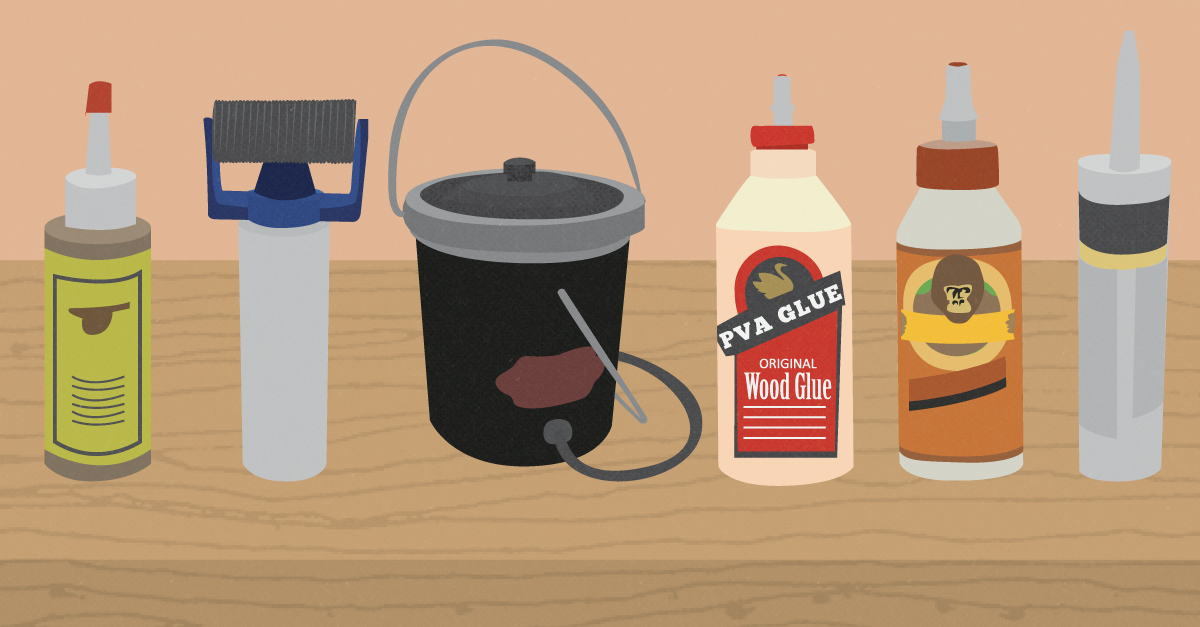- Gluing Tips
- Wood Glue
- Hot Glue
- References
Gluing Tips
- Think about how to maintain pressure while the glue cures. The simplest way is a clamp, but for irregular shapes, or pieces that are far from an edge, it can be difficult for a clamp to reach both sides. If the pieces are flat you may be able to stack them and put a weight on top
- When possible, do a dry fit. Assemble your piece without glue, including figuring out how to use the clamps. Then take it apart again, apply glue, and clamp it again.
Wood Glue
- Wood glue (“yellow glue” – aliphatic resin, a kind of PVA) is water-based. A piece of wood that has wood glue applied to it will swell slightly. This effect is strongest in MDF and weakest in plywood, but it still happens to plywood. A piece that fits into a slot without glue may not fit into the same slot once glue has been applied.
- Wood glue is not gap-filling. It only joins two pieces that are in tight contact. If there is a space between the pieces, and you fill the space with wood glue, this will not hold. (There is another glue, epoxy, that can fill gaps.)
- Glues have an “open time” (during which you can move the pieces into a position), a “clamp time” (during which they need to be clamped), and a “cure time” (before the glue completely sets – the piece can be unclamped and moved around during this time, just don’t apply any stress to the join). Wood glue’s open time is five minutes. This is how long you have after you apply the glue, before you clamp it. This is why you do the dry the fit.
- Wood glue does not stick to dry wood glue. If you have to undo a joint and start over, you will need to scrape the old glue off.
- Wood glue cleans up with water before it cures. Afterwards, you can scrape it off. If you apply enough glue, there is “squeeze out” from the joint, onto surfaces that are not glued. You can wipe the glue off from these surfaces before it cures, or scrape it after an hour. You can also use blue tape to protect surfaces from squeeze out. Then you can peel the tape off instead of wiping or scraping off the glue.
Hot Glue
Hot glue sets so quickly you can often just hold the pieces in place. (Make sure you don’t burn yourself!)
Hot glue is weak. It is appropriate for a small piece that is not load bearing, or to hold two pieces together while a slower glue sets or you use fasteners.
Hot glue is visible. This doesn't matter if the joint is inside a pocket or otherwise out of sight. Also you can decide that you want people to see the glue, and use colored hot glue or mix in glitter or other filler.
References
Complete Guide to Woodworking Glues
Use the match-maker chart for all of your glue-up needs Unless your woodworking projects are limited to knockdown furniture and timber-frame barns, you are already quite familiar with a variety of tubes, bottles, bags and jugs of this sticky stuff.
www.woodcraft.com

Choosing the Right Wood Glue
Most woodworking projects require some gluing-up. With the variety of glues on the market, how should you know which one is right for the job? The answer depends on what you are gluing up, and how the finished project will be used. Let's take a look at some of the most popular types of glue.
www.fix.com

Understanding Wood Glue - Which Type & Brand Is Best For My Project
There's no question that advances in adhesives technology over the years have made life easier and more predictable for woodworkers. A byproduct of that, however, is a confusing variety of types and brands of adhesives and not a lot of clear information.
www.rockler.com

Shorter guides:
Mike Farrington's most-used glues - FineWoodworking
By Mike Farrington Like most cabinet and furniture makers, I use a variety of glues. Along with nails and screws, glue is one of three ways to join wood. When done right, it is the strongest and most permanent. We are lucky to live in a time when we have so many different glues to choose from.
www.finewoodworking.com

5 Types Of Wood Glue - Woodworking Guides
You will find that is the one thing that joins all of your woodworking projects together. Literally! It is such a vital part of any woodworking project that you need to know about the different types of wood glue and how to use them.
www.woodworkingtrade.com

The Different Types Of Wood Glue And When To Use Them
There are many ways you can join two or more pieces of wood together. You can nail them together, you can use screws, you can use other forms of wood joinery techniques (such as dowels), and most importantly, you can glue them together.
craftsmanprotools.com
